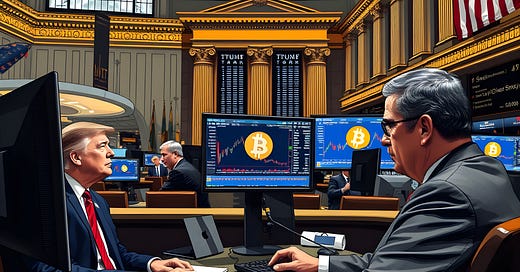The US Sovereign Wealth Fund: Fiscal Innovation or QE in Disguise?
Monetizing Government Assets for Public Prosperity — Or Repeating QE’s Perils?
"We're going to monetize the asset side of the US balance sheet for the American people. There'll be a combination of liquid assets, assets that we have in this country as we work to bring them out for the American people." - Scott Bessent, US Treasury Secretary
The promise of a US Sovereign Wealth Fund (SWF) captivates like a siren’s song: Imagine leveraging America’s vast assets—land, infrastructure, resources—to secure wealth for every citizen. It whispers of freedom, of a future where prosperity flows from government balance sheets to Main Street. But beneath this grand ambition lies a perilous question:
Is this the dawn of fiscal innovation—or déjà vu?
What Is a Sovereign Wealth Fund?
Sovereign Wealth Funds are state-controlled investment funds, usually financed by revenues from natural resources (like Norway's oil profits) or foreign reserves. The U.S. proposal takes a different approach, aiming to generate returns for public programs by monetizing federal assets such as infrastructure, land, or financial holdings. Essentially, this concept positions the government as a strategic investor acting on behalf of its citizens.
QE Recap: The Fed’s Crisis Tool
Quantitative Easing (QE) is a central bank maneuver to stimulate economies by purchasing bonds or assets, injecting liquidity to lower borrowing costs. Post-2008 and during COVID-19, the Fed expanded its balance sheet to roughly $9 trillion, propping up markets but drawing criticism for inflating asset bubbles and exacerbating wealth inequality.
Source: Federal Reserve
Why the SWF Could Mirror QE
Asset Purchases and Market Impact:
Like QE’s bond-buying spree, a U.S. SWF investing in equities or infrastructure could drive up asset prices. For instance, heavy SWF investment in green energy might inflate valuations, echoing QE’s distortion of housing and bond markets.Liquidity Injection:
If the SWF is funded by Treasury debt and the Fed buys that debt, it becomes a fiscal-monetary hybrid—effectively “QE through the backdoor.” This could flood markets with cheap capital, repeating QE’s liquidity surge.Wealth Inequality Risks:
QE disproportionately enriched asset owners. Similarly, an SWF investing in stocks might boost corporate valuations, favoring Wall Street over Main Street unless returns are redistributed equitably.Balance Sheet Expansion:
Both tools expand government balance sheets. While QE bloated the Fed’s holdings, an SWF funded by debt could balloon Treasury liabilities, raising long-term fiscal risks.
Key Differences: Why It Might Not Be QE 2.0
Funding Mechanism:
QE: The Fed creates money, a purely monetary tool with no direct taxpayer cost.
SWF: Likely funded by asset sales, leases, or debt issuance. If Congress approves debt financing, it’s fiscal policy—adding to national debt and interest burdens.
Primary Objective:
QE: Emergency stimulus to lower borrowing costs and avert deflation.
SWF: Long-term wealth generation (e.g., funding infrastructure, social programs). Success hinges on investment returns, not short-term liquidity.
Asset Ownership:
QE: The Fed temporarily holds bonds, eventually selling them back.
SWF: The government retains assets indefinitely, akin to Norway’s $1.6 trillion fund. This demands prudent governance to avoid political meddling.
Inflation Pathways:
QE’s money-printing risks inflation if liquidity outstrips growth. An SWF funded by asset sales might avoid this—unless paired with Fed debt monetization.
The Grey Area: When SWF Meets QE
The overlap intensifies if:
The Fed buys SWF-funded Treasury debt, creating a circular flow of liquidity.
The SWF takes on risky investments (e.g., tech startups), pressuring the Fed to backstop losses.
This “QE-adjacent” scenario blurs fiscal-monetary boundaries, socializing risks while privatizing gains—a key QE criticism.
Design Determines Destiny
The SWF’s resemblance to QE hinges on its structure:
If Debt-Funded + Fed Backstop: A stealth QE, amplifying market distortions and inflation risks.
If Asset-Funded + Independent Governance: A transformative tool, akin to Norway’s model, focusing on sustainable wealth without monetary side effects.
Secretary Bessent’s vague “monetize the asset side” leaves room for both outcomes. Clear rules on funding, transparency in asset selection, and firewalls against political interference are essential.
The Bottom Line: A Tightrope Walk
The U.S. SWF proposal walks a fine line between innovation and familiarity. While it holds promise to leverage public assets for broad prosperity, parallels with QE are undeniable—particularly if liquidity injections and Fed entanglement take center stage.
The takeaway? The Funds design is crucial. A well-structured SWF could sidestep QE’s pitfalls, but lax guardrails risk replaying its controversies. As details emerge, policymakers must prioritize transparency and accountability to ensure this tool serves the everyday people of Main Street, not just the interests of the 1% on Wall Street.
Agree? Disagree? Share your perspective below. For deeper dives into fiscal policy’s evolving landscape, subscribe now.





